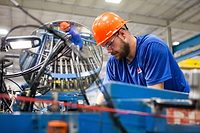Coating Tomorrow
Sustainable Breakthroughs in Manufacturing Processes

The need for sustainable practices in the manufacturing industry has never been greater. As large businesses continue to assess their environmental impact and become more transparent about their long-term goals for greener daily operations, eco-conscious technology is making its way to the forefront of the manufacturing industry.
For the paint and coatings industry in particular, finding ways to create a safe workplace through green alternatives prompted by the fourth Industrial Revolution is the best method for efficient supply chain optimization and positive environmental impact. We’ll review how the latest technology breakthroughs are boosting efficiency throughout the manufacturing process, and are creating a healthier environment for both consumers and team members.
Clean Energy Resources for Paint and coatings Manufacturers
Investing in clean energy practices is something businesses have been paying special attention to for the past decade. When it comes to practices within the facilities themselves, many manufacturers can cut down energy consumption by adopting eco-conscious delivery vehicles powered by biofuels like an ethanol-gasoline blend. This biofuel hybrid is partially derived from plants, mainly corn, and many different types of vehicles are built to run off a combination of ethanol and regular gasoline.
Though this isn’t a widespread practice, it can easily become a popular option amongst manufacturers who are looking to turn over a greener leaf. Since transportation is such a large contributor to carbon emissions, manufacturers can choose to work with vehicles that harness the power of biofuels in conjunction with traditional gasoline to significantly reduce their adverse environmental impact.
Employing energy-efficient appliances in paint and coatings manufacturing facilities is one of the best ways for businesses to lower their adverse environmental impact. Manufacturers like AkzoNobel have made public commitments to using appliances with renewable electrical energy sources, addressing and lowering energy consumption by reevaluating and updating common utilities like HVAC and cooling systems.
How Sustainability Encourages Efficiency for Manufacturers
Ultimately, sustainable practices lead to manufacturers creating more efficient production practices throughout their facilities. Currently, paint and coatings manufacturers are experimenting with reducing milling cycle times via pigments that are easily dispersed, narrowing down the dispersion process and therefore conserving energy. Not only does this work well for the environment, but quick milling processes reduce employee burnout, improving morale and boosting productivity.
Another tech implementation that is both employee and eco-conscious is the use of autonomous machinery. Thanks to Industry 4.0’s emphasis on Artificial Intelligence (AI), more manufacturers are developing operational practices that involve using Internet of Things (IoT) devices to streamline communication and production.
Sensor-based machinery doesn’t just reduce the need for constant human labor on a production line. The technology also learns best operational practices as it stores, transfers, and analyzes data, thereby lowering overall energy usage and overhead costs.
Cloud-based computing for team member communication is another energy-efficient practice that employs mobile technology and task management software to effectively delegate projects and relay issues or concerns. This reduces the opportunity for word-of-mouth miscommunications or a disrupted paper trail. With this technology, manufacturers can also allow some employees who do not have physically laborious jobs to work remotely, reducing commutes and in turn, lowering fossil fuel emissions.
Sustainability and Safety in Paint and Coatings Manufacturing
Safety is always the number one priority for paint and coatings manufacturers. To keep team members protected at all times, thoughtful training modules must be adopted in a way that doesn’t exacerbate costs or energy usage.
When being trained, new employees must experiment with the machinery, which can be both a lengthy and dangerous process. One way to assess any safety concerns and evaluate the best way to conduct training is to have all employees use wearable PPE devices that track employee vitals for signs of extreme stress and fatigue, which often contribute to workplace injuries. Having this data available is one of the best ways to figure out how to train new employees without forcing the trainer or trainee into irreversible points of exhaustion.
Additionally, to prevent injury caused by machinery operation further, manufacturers can conduct initial training via Augmented Reality (AR) devices, allowing employees to get a feel of how to operate machinery without thrusting them too early into an unfamiliar environment. Employees will feel more confident on the floor once they are fully trained, and energy usage and product waste can be regulated by not subjecting important machinery and items to excessive or accident misuse.
Waste Reduction Strategies for Paint and Coatings Manufacturers
Creating virtual reality training modules is one way to reduce unnecessary waste, but it may not have a significant waste-reduction effect in comparison to other strategies. The paint and coatings industry requires a ton of water consumption, which often results in the production of billions of tons of wastewater per year. Manufacturers can work with companies to recycle paint and coating wastewater, removing harmful components like latex through a filtration system so manufacturers can both reduce costs and use much less water for daily operations.
Proper disposal and waste management are issues that must be handled swiftly by manufacturers. Waste produced in manufacturing facilities is subject to being burned, creating toxic emissions that affect our planet’s ozone layer and rapidly contribute to vast climate change. Instead, manufacturers can work with third parties to resolve to bioremediation for waste disposal and treatment, turning harmful waste into hazard-free, recyclable materials.
Another way manufacturers can reduce waste is by committing to only using biodegradable or reusable containers. Using raw materials for paint and coating production is one of the best ways manufacturers can keep their businesses green without sacrificing quality. Companies can choose to package their products with containers made of recycled materials, an initiative that manufacturers like Noroo Paint are now opting for. For this brand specifically, product containers are made with an oxidative biodegradation agent called d2w, which helps the packaging get converted to water and biomass within five years.
Eco-conscious paint and coatings manufacturing methods are much easier than they sound. By making small changes throughout your manufacturing facilities, you can essentially double productivity while elongating the life of both your business and the planet we know and love. As manufacturers, taking the time to research and implement sustainable practices throughout your business is something that will encourage consumers to remain loyal to your products while creating a healthier workplace for employees, resulting in lower turnover rates and increased job satisfaction as a whole.
Looking for a reprint of this article?
From high-res PDFs to custom plaques, order your copy today!








